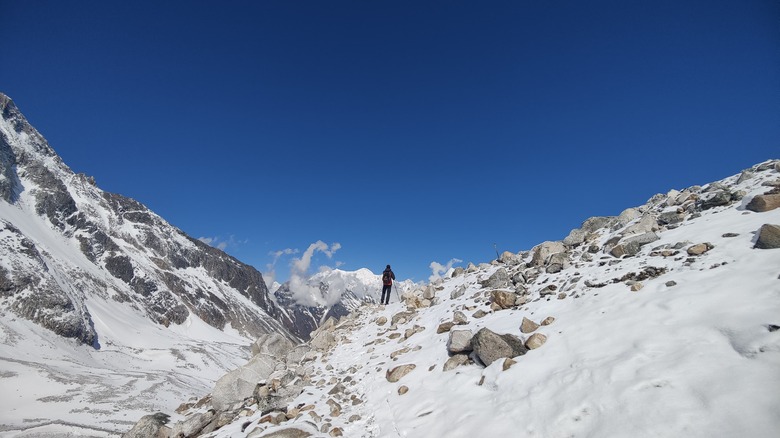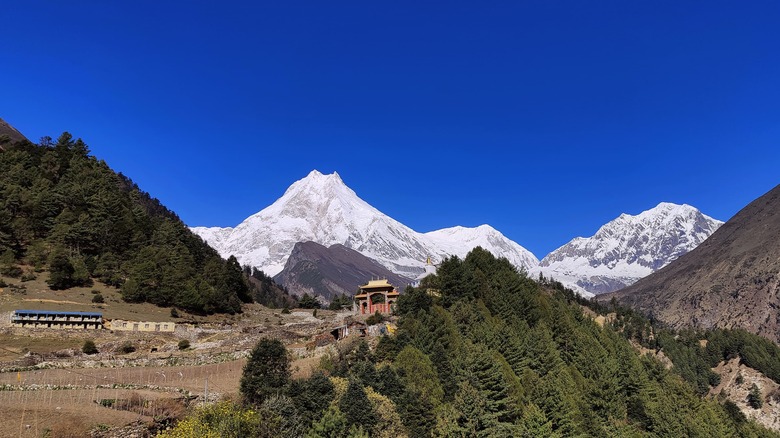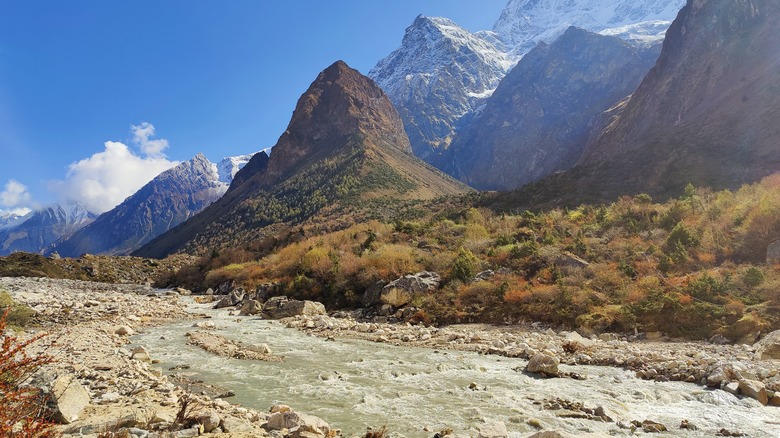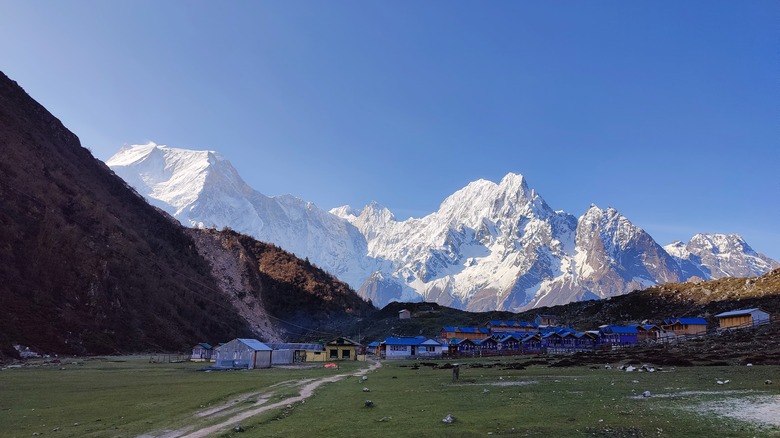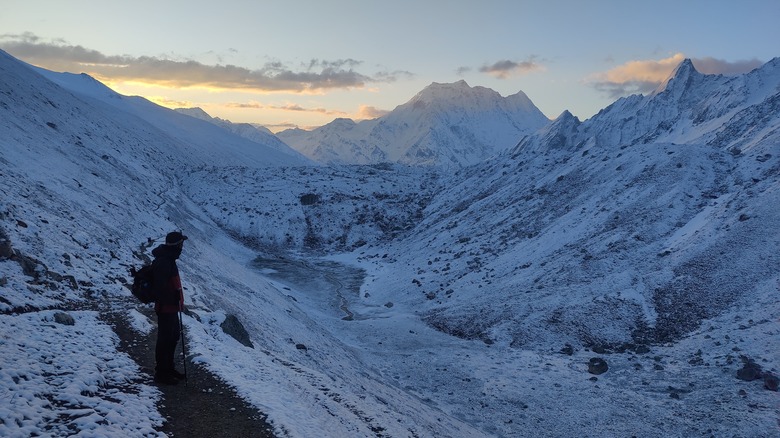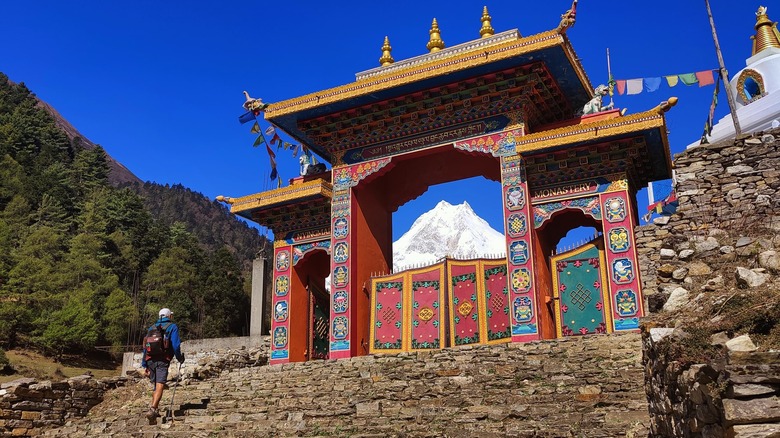The Little-Known Nepal Hike That Should Be On Everyone's Bucket List
Nepal is a trekker's paradise with endless mountains, trails, and adventures. Visitors to the country can spend months hiking through the towering Himalayas and witnessing the world's tallest mountains including Everest, Annapurna, and Manaslu. However, in recent years, some of the most popular trails have gotten crowded. While these crowds have brought more development to the region, they have also had some negative effects on this once rugged and off-the-beaten-path destination. For example, if you were to embark on the Everest base camp trek, you would probably expect to be in the middle of nowhere, surrounded by towering mountains, and disconnected from the outside world. However, in reality, you would find good access to WIFI, trails packed with people, and plenty of stylish coffee shops.
So, where can you go in Nepal to still get that secluded and rugged experience? The answer is Manaslu. Known by trekkers as "what the Annapurna circuit used to be," the Manaslu circuit trek is the lesser-known Nepal hike that anyone who loves off-the-beaten-path adventures should add to their bucket list. I was lucky enough to hike the Manaslu circuit during my last visit to Nepal and can confidently say that I enjoyed every beautiful and grueling moment of it. So, here is my advice about why you should visit Manaslu and how to plan your trek.
What is the Manaslu circuit trek?
The Manaslu circuit trek is a 13 to 15-day thru-hike that takes trekkers in a counter-clockwise loop around Mount Manaslu, the eighth-highest peak in the world. This high-altitude trek starts in the village of Macchakhola at an elevation 2,851 feet (869 meters) and rises up to 16,752 feet (5,106 meters) at its highest point — the Larke Pass, where you will be surrounded by dramatic 360-degree views of snow-capped mountains.
The Manaslu circuit is a strenuous journey and does typically require training and some prior high-altitude trekking experience. It also requires a degree of mental toughness to be able to trek through any weather conditions for up to nine hours a day and then wake up the next day ready to do it again. But if you are up for the challenge, the views are breathtaking and the trail is peaceful and uncrowded.
The trek is also customizable and, if you are willing to add a day or two, you can visit Birendra Tal (a turquoise-green glacial lake), the Pungyen Gompa Monastery, or Manaslu base camp which sits at 15,092 feet (4600 meters) above sea level and is where mountaineers begin their summit journeys. We skipped the monastery, but added the two-hour trek to the beautiful Birendra Tal and the strenuous nine-hour trek up to Manaslu base camp.
What you will see on the Manaslu circuit
One thing I loved about the Manaslu circuit was that the views on the trail were as beautiful as they were varied. The first day of walking took us through villages filled with farm animals and laughing school children who greeted visitors with a cheerful "Namaste," whereas day two ventured through quiet pine forests filled with trains of pack mules decorated with red tassels. We got our first glimpse of Manaslu's snow-capped twin peaks on the fourth day of walking and, by the mid-point of the trek, were completely surrounded by soaring mountain ranges.
On top of breathtaking views, the Manaslu circuit trek also offers insight into a unique local culture. While most of Nepal is culturally Hindu, the Manaslu circuit region is inhabited by Tibetan Buddhists. This gives trekkers the opportunity to get a glimpse into this slowly disappearing way of life which can be seen in the various idyllic villages, white stupas decorated with colorful prayer flags, ancient temples, and monk-filled monasteries along the trail. Unlike more developed treks, the cultural experience at Manaslu is genuine as the villages you stay in along the way are not solely there for tourism. Instead, they are fully functioning communities that engage in traditional work like farming, raising livestock, and weaving — much as they have for hundreds of years.
What to know before you go
Like many treks in Nepal, the Manaslu circuit trek is a teahouse trek meaning that there are guesthouses available in every village. This makes the trek more accessible and affordable because you won't have to pack your own tent, food, or cooking supplies. While many guesthouses offer Western food like pizza and sandwiches, these options are typically underwhelming. I found that it is better to go with local dishes like the standard dal bhat (lentil stew and rice), egg curry rice, or potato curry rice.
While some guesthouses in the earlier villages may offer private bathrooms and western toilets, as you get higher up, shared bathrooms with squatty potties will be the only option. Electricity is often weather dependent, and some villages may not have electricity at all. We went three days with no electricity and used portable batteries to keep our phones charged. This was difficult because batteries die more quickly in cold weather; however, there are a few methods you can employ to keep your phone charged in low temperatures.
In order to trek in Nepal, it is required that all foreign visitors book their trip through a registered Nepali trekking company and hire a guide. While porters are not required, they are often recommended. For our group of three trekkers, we hired one guide and two porters.
What type of gear is needed?
Because of the large change in elevation during the Manaslu circuit trek, the weather is very different during the different stages of the hike. This means that you will likely require a variety of trekking clothes from shorts and T-shirts to thermals, down jackets, thick socks, and warm gloves. You will also need trekking shoes with a good tread, trekking poles, and a hat to help protect your skin from the sun. At high-altitudes, it is easier to simply cover up on the trail instead of using sunscreen.
Larke Pass is considered the most difficult day of the trek (if you don't include Manaslu base camp) and most teams start the Larke Pass day early in the morning while it's still dark. This means you will need a headlamp to help you see the trail. If you're like me, then a headlamp is also useful in villages with no electricity when you need to use the bathroom in the middle of the night.
The most dangerous part of the Manaslu circuit trek is the trail after Larke Pass when you begin your almost 5,000-foot descent to the next village. This trail is very steep and usually covered in patches of snow and ice. Because of this, you will need microspikes to stay safe and keep from slipping and getting injured.
Manaslu circuit safety
The Manaslu circuit trail does include some areas where you will need to step carefully. This primarily involves places where recent landslides or avalanches have covered the original trail and you need to walk over shifting rock or snow above a steep drop. This is another reason why having the right gear (microspikes, trekking poles, and good shoes) is important. Also, you will have a Nepali guide with you to help you get through any difficult sections.
Because of the large change in elevation involved in the Manaslu circuit trek, the biggest health risk is typically altitude sickness. You should familiarize yourself with the signs and symptoms of altitude sickness before you go and have a plan for what you will do if you experience them. Altitude sickness can affect anyone at any time — no matter your experience or fitness level. The best deterrent for altitude sickness is to ascend slowly, eat lots of carbs, drink plenty of water, and get enough rest. You can also take preventative medicines if you have a history with altitude-related illnesses.
The last thing you should keep in mind on the trail is water. While fresh water is widely available, it is not potable. So, you will need to have a water purification method ready, whether that's through a filter system or purification tablets.
